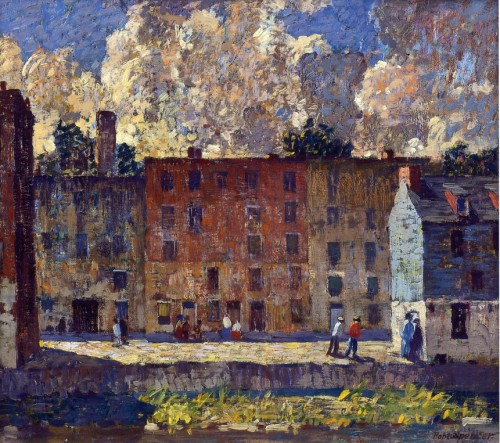Urban renewal is increasing as new young professionals and families seek residences closer to city centers. Many are finding apartments and homes in neighborhoods that have declined in population and economic success. The appeal of suburban life has lost its allure in the eyes of many college grads who prefer dense, urban living. Cities have cultural events, job markets, parks, and a diversity of people not found in typical suburban subdivisions. The ballet is not likely found outside city limits, nor jobs in marketing and publishing. Central Park in New York, Rittenhouse Square in Philadelphia, and the National Mall in Washington, D.C., all possess a certain je ne sais quoi. Billionaires buy up residences on Fifth Avenue because of Central Park.
Yet, one is likely to find a hipster there who took the subway in from Williamsburg, Brooklyn. It is desireable to live next to the parks, but it is shared by all the city residents. The public spaces and streets of the city make for an interesting array of people in all their diversity. The city becomes a microcosm for the world. All these benefits are outweighing the security of suburban life, and one-time suburbanites are migrating into city neighborhoods. This urban renewal changes the city one neighborhood at a time, and the change is often seen as gentrification.
Gentrification can be viewed as both a positive and a negative. As a positive, it is seen as the improvement of a neighborhood both in terms of architecture and safety. As a negative, it is seen as an injustice to poor residents who are displaced by rising property value. As Catholics, we need to be concerned about the plight of the poor, especially if our own actions cause them additional hardship. However, before we assess the moral import of gentrification, we have to better understand what constitutes gentrification as a physical and social phenomenon. This article will show the relationship between mass-production, restorers, and developers, and man’s desire for a beautiful city. The article will stop short of a moral discussion of gentrification and, instead, will analyze it from an architectural point of view.
Mass-Producing Gentrification
The same neighborhoods that are seeing change today saw change during the mid-twentieth century. At that time, Americans desired suburban life over urban life. The car made it possible for workers to commute long distances on smoothly paved Eisenhower highways. His Federal Aid Highway Act of 1956 invested billions of dollars for the construction of approximately forty thousand miles of roads. Transportation of commerce and people became a breeze. The result revolutionized interstate travel, and cities soon were similarly connected to the surrounding rural areas. The unmatched freedom of the automobile began to impact the landscape as farms soon became subdivisions. The American dream often concretized into a single-family detached home with a white picket fence, green lawn, and garage.
As developers flocked to the heartland in order to grow homes on cornfields, the city became voided. (See modern-day Detroit for a severe example.) The city started to lose its neighborhood feel as homes were abandoned, business districts were established, and markets moved out. In 1965, President Lyndon B. Johnson established the Department of Housing and Urban Development (HUD). The additional aid given for public housing projects and subsidized rent responded to the disorder of the abandoned cities. Much like the Highway Act of 1956, the establishment of HUD sped up the production of institutional buildings and subdivided homes. Whereas the farm lands of the heartland were subdivided by suburbanites, the abandoned victorian homes on Broad Street were subdivided into affordable apartments by urbanites.
The initiatives of Eisenhower and Johnson along with the mass production of suburban housing contributed to the rapid change of American neighborhoods. These programs and investments distributed the middle class on the outskirts of the city and concentrated poverty within the city. Both sprawl and concentrated poverty created homogenization on city blocks and suburban streets. Both areas were aided by the mass production of roads, houses, and apartments.
Mass production is responsible for gentrification in the United States and abroad. Following the bombings of WWII, a section of east London known as Bethnal Green was left decimated and void. In the mid-1940s, development began similar to the public housing projects of HUD. The industrial development provided for a large, quick transformation of the empty lots. It was in this area that the German-born British sociologist Ruth Glass coined the term gentrification. She reported that poorer residents of the neighborhood were being pushed out by wealthier residents moving into the area. Her study showed that the new people were of a higher social class than the current residents. There was a change in the architecture and in the economic class of the residents. Therefore, we see that gentrification is dependent upon the existence of a poor demographic which is usually the result of some negative action. In London it was bombing, and in America it was suburban sprawl. Gentrification is, then, the change of an impoverished area into an affluent area quickened by mass-produced development.
Restoration and Development
Two types of agents cause gentrification, the restorer and the developer. The restorer seeks an affordable residence near employment and cultural opportunity. Often, these homes had been abandoned during the 1950s and are now situated in rough neighborhoods. The homes tend to be well designed and have the potential to be restored. The architecture is good and sold at discount. The second agent, the developer, waits for an area to show signs of improvement—usually indicated by lower crime rates and higher property value. Typically, the new restorers enter a neighborhood, and the developer sees the improvement. Though the developer and restorer both improve a neighborhood, they do so differently. The restorer buys a house to restore it. A developer buys a block to destroy it, albeit for the purpose of building a new complex. The restorer discovers good architecture and seeks to preserve it. The developer sees undesirable or expendable architecture and replaces it. He buys a city block, razes the buildings, and erects a chic new mid-rise mixed-use building (e.g., a building with movie theaters, grocery stores, gyms, street shopping, and apartments). One can cite numerous examples of city neighborhoods transformed by entrepreneurs and new restorers. In the Capitol Hill neighborhood of Washington, D.C., new residents have restored Victorian townhomes to their original glory. Additionally, the Brookland neighborhood (home to The Catholic University of America and the Dominican House of Studies) now has mid-rise buildings with commerce on the street level and residences above.
Restored historic homes and new commercial opportunities in neighborhoods increase desirability. The real estate market reflects the increased desirability and tax-assessed property value increases. This increase translates into higher property taxes, rent, and overall cost of living. A loaf of bread in Manhattan costs more than one in Lima, Ohio. As affluent residents move in, prices increase, and consequently the poor must move out. There is a strong correlation between the socioeconomic standing of restorers/developers and increases in rent. Because property value and rent are based upon a commercial market, the price rises as desirability rises. From a Marxist perspective, this looks sinister. The higher social class appears to be oppressing the lower social class. Are the words of Leo Tolstoy true: “The rich will do anything for the poor except get off their backs”?
This perspective is lacking. Marx is wrong because social classes do not make concrete acts. Ruth Glass observed the development of East London using a sociological lens; her analysis focused on economic class. Her study abstracted and simplified reality in order to learn patterns. The study did not investigate the motivations of individuals involved in Bethnal Green’s transformation. Gentrification results from individuals buying, renovating, and developing. Those persons are either restorers or developers. The restorers renovate a neglected property, while the developers remove undesirable properties, building new, useful ones. The former moves in and resides in a neighborhood. The latter changes the neighborhood from the outside, but the change is for the better. The consequential increase in cost of living reflects more the improvements made to the neighborhood than a malicious driving out of current, poor residents. Truly, if a rich person intentionally supplants a poor person for gain, he would be sinister. Shelter is a basic human right. Yet, one would be hard-pressed to find such a restorer and developer. No one is guilty of sin for buying a house and planting tomatoes, nor for clearing delinquent properties and building grocery stores.
Nevertheless, the actions of restorers and developers do indirectly affect the poor. Affordable residences dwindle in a given area or are displaced to another area of a city. In some European cities, such as Paris, the suburbs have become areas of concentrated poverty. This is a cause for concern because those in poverty often have to make long and expensive commutes into the city. This is becoming more of a reality in the United States as well, and it raises the question of a “structure of sin.”* Much can be written on the tenuous relationship between block investing, tax assessment, zoning regulations, neighborhood lobbying, and eminent domain. There are many people and groups involved in major developments, all of whom can be negligent to the common good in specific instances. It would be reductionist to attribute blame to a specific developer or a restorer for the plight of the poor in general, but one cannot ignore the need to address the issue. Limiting the investigation to the acts of the two agents, the restorer and developer, we can learn something of their desire and end goal. This can give a focused insight into the negative consequences of gentrification, particularly the displacement of the poor.
The roots of gentrification begin with the development in the mid-twentieth century. It predominantly resides in the commercialization and mass production of housing. The streamlined production of suburban houses following the Federal Aid Highway Act served to homogenize neighborhoods, impoverishing those in the city. The utilitarian brick buildings of HUD exacerbated the concentration of poverty. The buildings lacked architectural integrity; the neighborhoods lacked diversity; and society began to abandon cultural identity as it pertains to housing. Restorers reacted against the works of developers who did not seek to build properly beautiful homes.
In his recent encyclical on the environment, Pope Francis comments on this cultural issue. He writes, “If architecture reflects the spirit of an age, our megastructures and drab apartment blocks express the spirit of globalized technology, where a constant flood of new products coexists with a tedious monotony” (Laudato Si 113). He frames this comment within chapter 3, “The Human Roots of the Ecological Crisis.” His sharp critique brings to mind the brown brick high-rises that line the east side of lower Manhattan, among other countless examples. Our Holy Father sees something disordered in modernity’s account of the foundation of humanity, and subsequently mundane buildings rise from those supports. The resulting buildings tend to be highly efficient and functional. The walls of the buildings are technically sophisticated, often composed of hundreds of parts and systems. However, those parts arrange to make an unseemly whole, a drab building. Technology and construction assembly are important to architecture, but there is something to the art which should order the use of technology and construction assembly. Pope Francis sees this as a faulty approach that results in a troubled society with bad architecture.
In many respects, the issue of gentrification is a response to the drab and mundane that our Holy Father condemns. The restorers that move into crime-ridden neighborhoods often do so because they find homes with potential. Well-designed homes that fall into disrepair have an allure, which restorers desire to restore and preserve. The typical house built after WWII tends to be of a lesser quality than those built before. Famed international architect and theorist Rem Koolhaas has noticed that there is a perceptible shift in America to preserve quality works of architecture. In a lecture to Columbia University’s Graduate School of Architecture, Planning, and Preservation (GSAPP), he announced that “preservation is overtaking us.” He demonstrated his claim via a graph depicting changes to preservation laws from 1818 to 1960. In 1818, works of architecture two thousand years or older were protected by law, but by 1960 that date could be defined as merely twenty years. Koolhaus says words that echo those of Pope Francis: “[Preservation] makes perfect sense because it is clear that we built so much mediocrity that it is literally threatening our lives.”
Restorers are shirking the benefits of suburban living (land, space, security, etc.) for the chance to live in a building and a neighborhood that is beautiful, albeit potentially. What ends up following these lovers of beauty are developers. The developers dismantle utilitarian buildings that are not worth preserving. Progressively, the buildings erected by the developers are reflecting the more traditional architectural designs that the pioneering restorers seek. However, the motivations between the two agents of gentrification differ.
The following quote from Pope Francis will help to elucidate the difference between the restorer and the developer. In Laudato Si, he says, “There is also an historic, artistic and cultural patrimony which is likewise under threat. . . . It is not a matter of tearing down and building new cities. . . . Rather, there is a need to incorporate the history, culture and architecture of each place, thus preserving its original identity” (140). The restorer that renovates an existing home preserves the original identity that the Holy Father references. However, a developer must decide to tear down and build new. Bad developers tear down good architecture, but good developers incorporate it. A good developer sometimes must tear down poor buildings in order to erect new ones. But the specific difference between the actions of the restorer and the developer is their vested interest regarding the cultural identity of the neighborhood. There is an authenticity in the older buildings of a gentrified area that is not present in the newer buildings. It is often evident in the scale of buildings and the integrity of construction. Newer buildings in gentrifying areas tend to be larger in scale, dwarfing neighboring existing buildings. While developers and their architects are often designing new buildings to harmonize with existing context, the appearance of the new buildings is not authentic. Because of advancement in technology and construction systems, developers can mimic older architecture and craft at discount. For instance, some newer buildings tend to have exterior brick walls that are one brick thick and non-structural. Older buildings have exterior brick walls that are structural and two or three bricks thick. The former is aesthetic while the latter is structural, durable, and aesthetic. This helps to reveal the rationale of the developer. The developer has tried to engineer a way of obtaining an appearance without paying for it. The developer wants a brick-looking building without paying for a brick-constructed building.
Gentrification is a sociological term that studies change based upon socioeconomic status, but this should not criminalize restorers and developers. Those who move into an area or develop it are not necessarily guilty of any heinous act. The mass production of roads and government-assisted housing created the opportunity for gentrification, and the commercial development of suburban subdivisions and public housing created homogenized neighborhoods that lacked cultural identity or beauty. Gentrification thus results from people desiring to preserve good architecture and live in beautiful neighborhoods. The negative consequences of gentrification occur mostly because of the relationship between tax assessment, property value, rent, and cost of living. Herein, it is important to distinguish the different motivations and approaches of the restorer and the developer. The former seeks an end in a beautiful, well-designed neighborhood. The latter seeks to improve an area by designing new, large complexes that mimic historic buildings at an effective cost.
The Desire for a Beautiful City
It is apparent at this point that gentrification is a complicated matter that is connected to mass production and industrial‐ization. Pope Francis in Laudato Si has commented extensively on how commercialization has affected man and, as a result, the environment. While Pope Francis’ ecology is outside the scope of this article, it is worth noting that the Holy Father has seen something intrinsically disordered in the way man has designed housing. The past half-century has ultimately left man dissatisfied with respect to local architecture. But, the ultimate goal of developers can undermine that of the restorers. If developers simply operate from a purely economic framework, they will make the same mistake developers did in the mid-twentieth century. Their buildings ought not merely mimic historic buildings in appearance, but must mimic the historic buildings in fulfilling the principles of architecture. As Pope Francis says, “It is not enough to seek the beauty of design” (LS 150).
The Ten Books of Architecture, written by Vitruvius to Caesar Augustus, is the oldest theoretical work of an architect. Within his writing, Vitruvius suggests a triad for any architectural work. It must possess utilitas, venustas, an firmitas. Utilitas easily translates into utility or function. It speaks to the use of the building, its arrangement of rooms, the size of rooms, etc. Not only should the interior of the building fulfill programmatic requirements, but the exterior must as well. Any building that engages the public sphere of the street has a responsibility to that street. The church plaza is a good example of this idea. Were St. Peter’s in Rome to open onto an alley rather than the elegant square designed by Bernini, one could imagine the congestion and burden it would be to Rome. The second part of the triad is venustas, and it translates to delightful, charming, or beautiful. Its application involves harmony, proportion, and aesthetic. This tends to be a controversial and disputed principle within modern architecture. Ideas such as symmetry and classical proportioning are disregarded as antiquated and rigid. However, the only true argument against traditional proportions is that it is not original or experimental. Modern design seeks to discover new aesthetics ex nihilo, apart from any tradition. This approach has had minimal success. For the most part, it has produced fads that tend to have a decade-long appeal. Buildings designed with this approach to venustas tend to be dated, labeled as sixties, seventies, etc. The third and final principle is firmitas, which translates to strength. It corresponds to the durability and structural integrity of a building. Often, this last quality is talked about in terms of permanence. Interestingly, permanence extends beyond its ability to withstand weather, war, and natural disaster; it also includes the potential to be preserved. The enduring works of architecture are maintained and fixed over the course of many centuries because of their excellence which transcends fads and trends.
Philosopher Jacques Maritain states that beauty is not an object of art nor its end. He says beauty is the end beyond the end. The latter end in that statement refers to the object of art, which is the good of the work. The goodness of the work is something distinct from beauty for Maritain. He too would agree with Pope Francis: “It is not enough to seek the beauty of design.” Therefore, a developer who ignores the Vitruvian principles stated above treats beauty as an end and not the end beyond the end. A developer who mimics the appearances of existing buildings and ignores the Vitruvian triad creates stage sets. Without utilitas, venustas, and firmitas, a building is not good architecture. It may take a few years for a building lacking firmitas to show, but there are countless examples of faulty and cheap construction being exposed after a few decades. Those buildings are likely to be torn down and replaced. Similarly, if a building lacks utilitas, it will become apparent within a few years. Schools built in the seventies with open floor plans ended up being renovated or replaced because the rooms failed to foster an environment for learning. Again, like the building lacking firmitas, these failed to be good. Beauty is the end beyond the end. Therefore a design that is not good is not beautiful and is not worth preserving. As a result, if developers value economic profit to the detriment of any of the three principles of good architecture, their buildings will conflict with the final goal of restorers. The area will not possess a cultural identity nor buildings that have an enduring beauty.
It is therefore imperative to design good buildings in order that neighborhoods become potential areas of gentrification. Today, drastic projects of developers are unfortunately linked to displacing the poor. Yet, these drastic changes exist because people are living in neighborhoods that lack cultural identity. Should a neighborhood and city be designed well, it will have a better chance of stability. When something is beautiful, people will gravitate toward it and wish to be with it. Mass production ignores man’s desire for the beautiful in favor of economy and use. Restorers desire a beautiful home, neighborhood, and city. Should developers working on larger scales disregard the restorers’ desires, they will undermine them. The mass production of housing that did not follow Vitruvian principles ultimately formed undesirable neighborhoods. When designs extend beyond superficial appearance and possess utilitas, venustas, and firmitas, they begin to have cultural value. Those who live in and around such buildings value them because they possess the end beyond the end. Pope Francis has an insightful take in his Evangelii Gaudium: “How beautiful are those cities which overcome paralysing mistrust, integrate those who are different and make this very integration a new factor of development! How attractive are those cities which, even in their architectural design, are full of spaces which connect, relate and favour the recognition of others!” (210).
To download a printable PDF of this Article from
Dominicana Journal, Winter 2015, Vol LVIII, No. 2, CLICK HERE.
Endnotes
* In the encyclical Sollicitudo Rei Socialis, Pope St. John Paul II raised the issue of structures of sin. He said that it results from complacency and cowardice to change current injustices. The Pope’s analysis differs from a Marxist perspective because it focuses upon individual sins, whose social ramifications can sometimes be difficult to cite. It is not possible to address the subject matter of individual sins in this paper. Instead, this paper will focus on artistic acts rather than moral acts.







